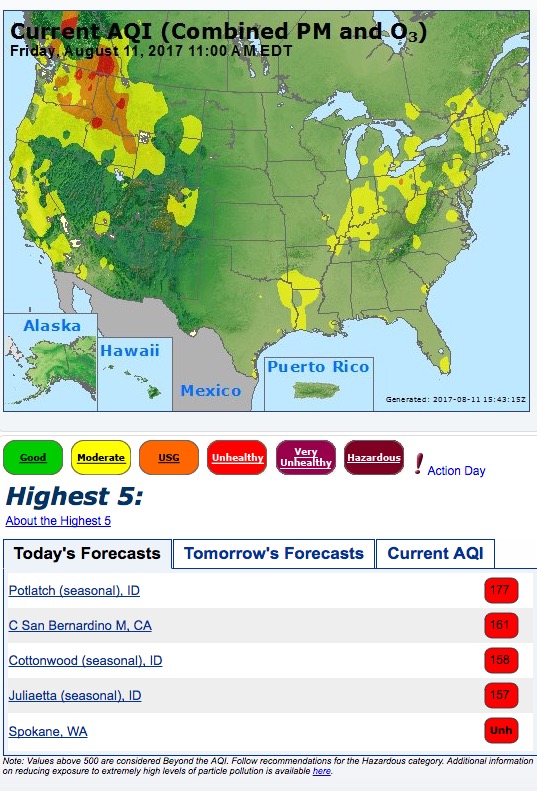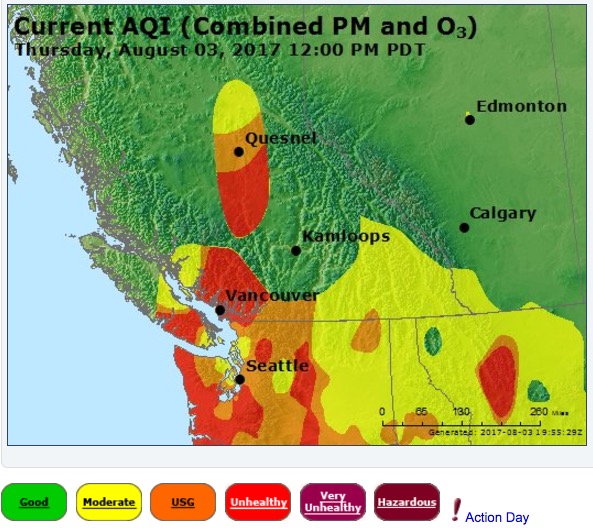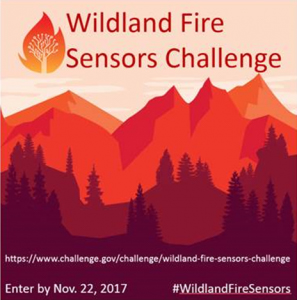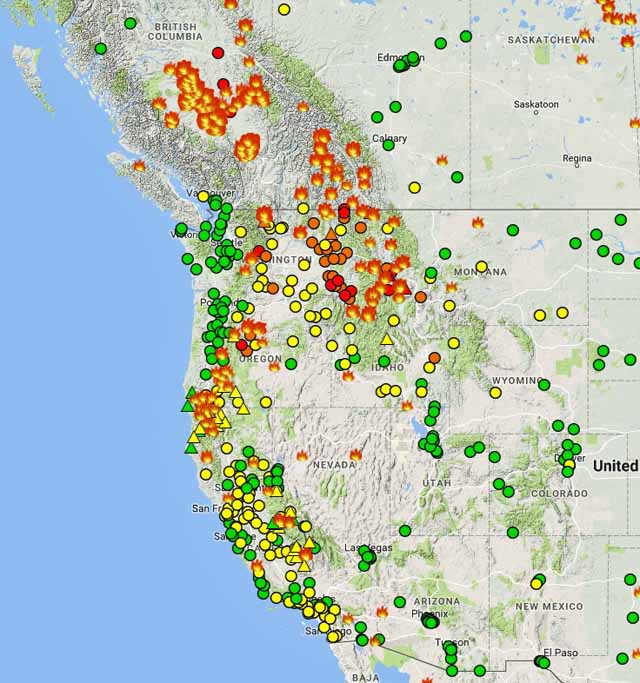
Tag: air quality
15,000 firefighters are battling 83 wildfires in the United States
Above: Map showing heat detected on wildfires in the northwest one-quarter of the U.S. by a satellite, August 10-11, 2017. NASA.
(Originally published at 12:34 p.m. MDT August 11, 2017)
Over 15,000 firefighters are assigned to 83 active wildfires in the United States which have burned a total of about 942,000 acres. In addition to fire overhead and incident command post personnel, they are staffing 369 hand crews, 678 fire engines, and 141 helicopters. So far this year over 6 million acres have burned in the country.
As you can see below, the air quality compromised by smoke is not getting any better. Again, four cities in Idaho and Washington are four of the top five locations in the country with forecasts for the worst air today.
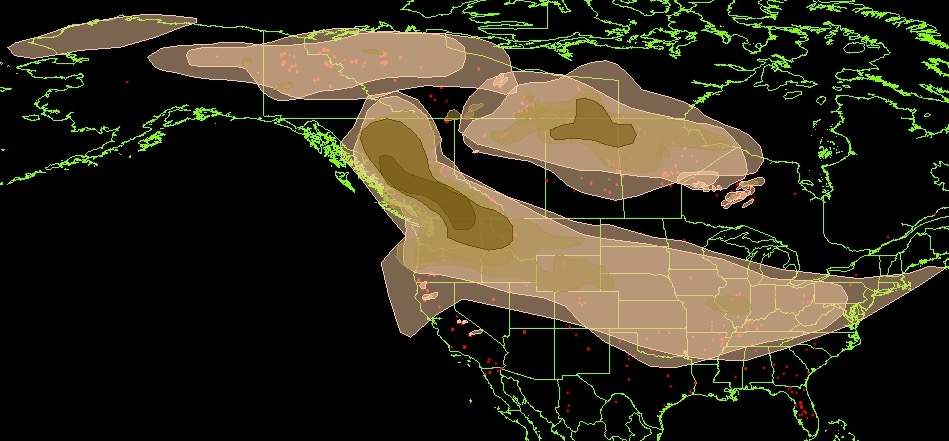
Wildfire smoke and air quality, August 10, 2017
Above: map showing the distribution of wildfire smoke at 5:34 p.m. MDT August 10, 2017. NOAA.
(Originally published at 6:09 p.m. MDT August 10, 2017)
Judging from these maps, the air quality in southern British Columbia and the U.S. Northwest looks particularly rotten today. (“Rotten” is not a term I’ve seen NOAA use to describe air quality, but it seems appropriate here.)
Locations in Washington and Idaho had the distinction of taking four of the top five positions on the forecast for the “highest 5”, AKA worst air, in the United States today.

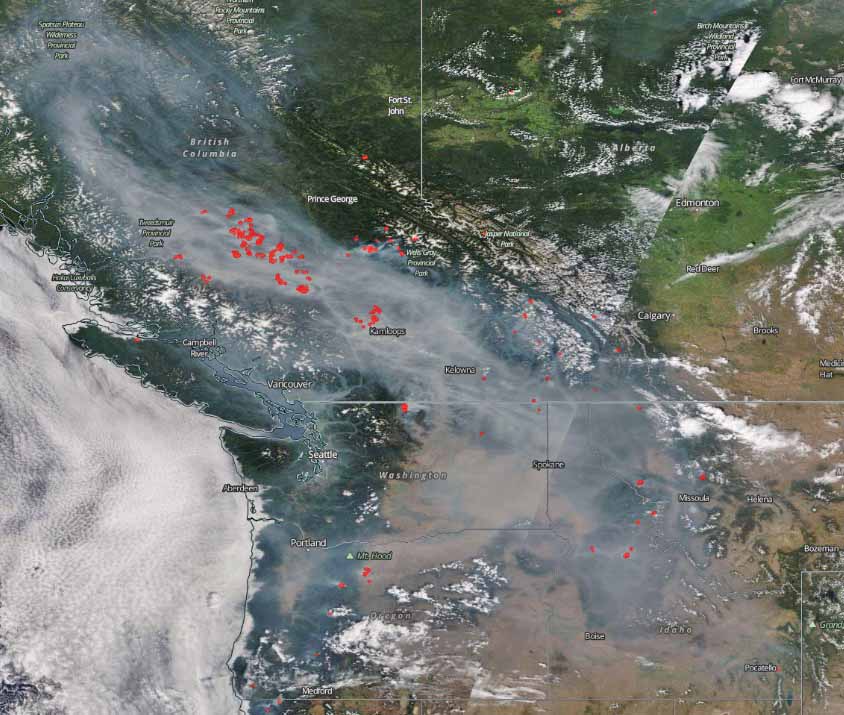
Wildfire smoke produces haze over much of British Columbia and the U.S. Northwest
Above: Satellite photo of smoke from wildfires in the U.S. Northwest and Southern British Columbia, August 5, 2017. The red dots represent heat detected by the satellite.
(Updated at 6:50 p.m. MDT August 5, 2017 to add the more current satellite photo above.)
Smoke from wildfires in Southern British Columbia continues to pour across the border into Washington and other states in the U.S. Northwest. The air quality in Washington is the worst that residents have seen in recent years, reaching unhealthy levels in some areas according to agencies that monitor particulates and other pollutants.
Currently there are 110 active wildfires in British Columbia — four of them are larger than 50,000 hectares (123,000 acres):
- Hanceville Riske Creek, 148,000 hectares (365,000 acres) approximately 60 km southwest of Williams Lake.
- Elephant Hill, 110,000 hectares (272,000 acres), near Ashcroft.
- Tautri Lake, 73,000 hectares (180,000 acres), 80 km northwest of Williams Lake.
- Baezaeko River-Quesnel West, 55,000 hectares (135,000 acres).
Below is a gallery of maps and graphics showing the location of the fires, air quality, and smoke. Click on an image to see a larger version and start a slide show. Captions are in the top-left corner.
Wildfire smoke produces “unhealthy” conditions in some areas of the US Northwest and British Columbia
Above: The distribution of wildfire smoke, current as of 2:09 p.m. MDT August 3, 2017.
(Originally published at 2:50 p.m. MDT August 3, 2017)
Smoke from wildfires in the United States Northwest and southern British Columbia is accumulating in those areas causing, in some areas, significant degradations in air quality. In British Columbia many massive fires combined with light winds has resulted in the smoke not being transported out of the area.
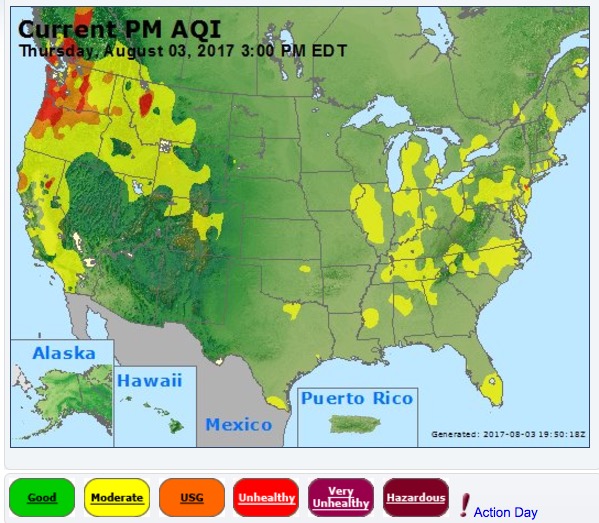
Some areas in BC, western Montana, and the western portions of Washington and Oregon have “unhealthy” air quality today, according to Air Now.
EPA wants to develop low-cost sensor system to monitor smoke
 The Environmental Protection Agency has announced an initiative to develop a new low-cost system that could monitor air quality affected by smoke from wildland fires. The existing hardware is large, cumbersome, and expensive, thereby limiting the number of monitoring stations and the data that is available to help officials provide appropriate strategies to minimize smoke exposure.
The Environmental Protection Agency has announced an initiative to develop a new low-cost system that could monitor air quality affected by smoke from wildland fires. The existing hardware is large, cumbersome, and expensive, thereby limiting the number of monitoring stations and the data that is available to help officials provide appropriate strategies to minimize smoke exposure.
Below is an excerpt from the EPA’s announcement about what they call the Wildland Fire Sensors Challenge. The three graphics were part of the agency’s news release.
Today, emerging technologies – including miniaturized direct-reading sensors, compact/powerful microprocessors, and wireless data communications – offer the opportunity to develop new systems to quickly gather and communicate air pollution data.
Wild fires are increasingly common events that produce significant air pollution, posing health risks to first responders, residents in nearby areas, and downwind communities. Also, wild fires are increasing in frequency and intensity, and the fire season is growing longer. Prescribed fires, which are used to manage ecosystems or reduce risk of wild fires, are typically managed to minimize downwind impacts on populated areas; however, people in close proximity may still be exposed to smoke. The description “wildland fires” refers to both wild and prescribed fires.
This challenge seeks a field-ready prototype system capable of measuring constituents of smoke, including particulates, carbon monoxide, ozone, and carbon dioxide, over the wide range of levels expected during wildland fires. The prototype system should be accurate, light-weight, easy to operate, and capable of wireless data transmission, so that first responders and nearby communities have access to timely information about local air quality conditions during wildland fire events.
The EPA is partnering with several agencies to develop this equipment: Forest Service, National Park Service, National Oceanic and Atmospheric Administration, National Aeronautics and Space Administration, and Centers for Disease Control and Prevention.
However, with the current Administration’s intended massive cutbacks to the EPA and even scattered calls to eliminate the agency, finding the money and staff to bring this idea to fruition is anything but a slam dunk.



